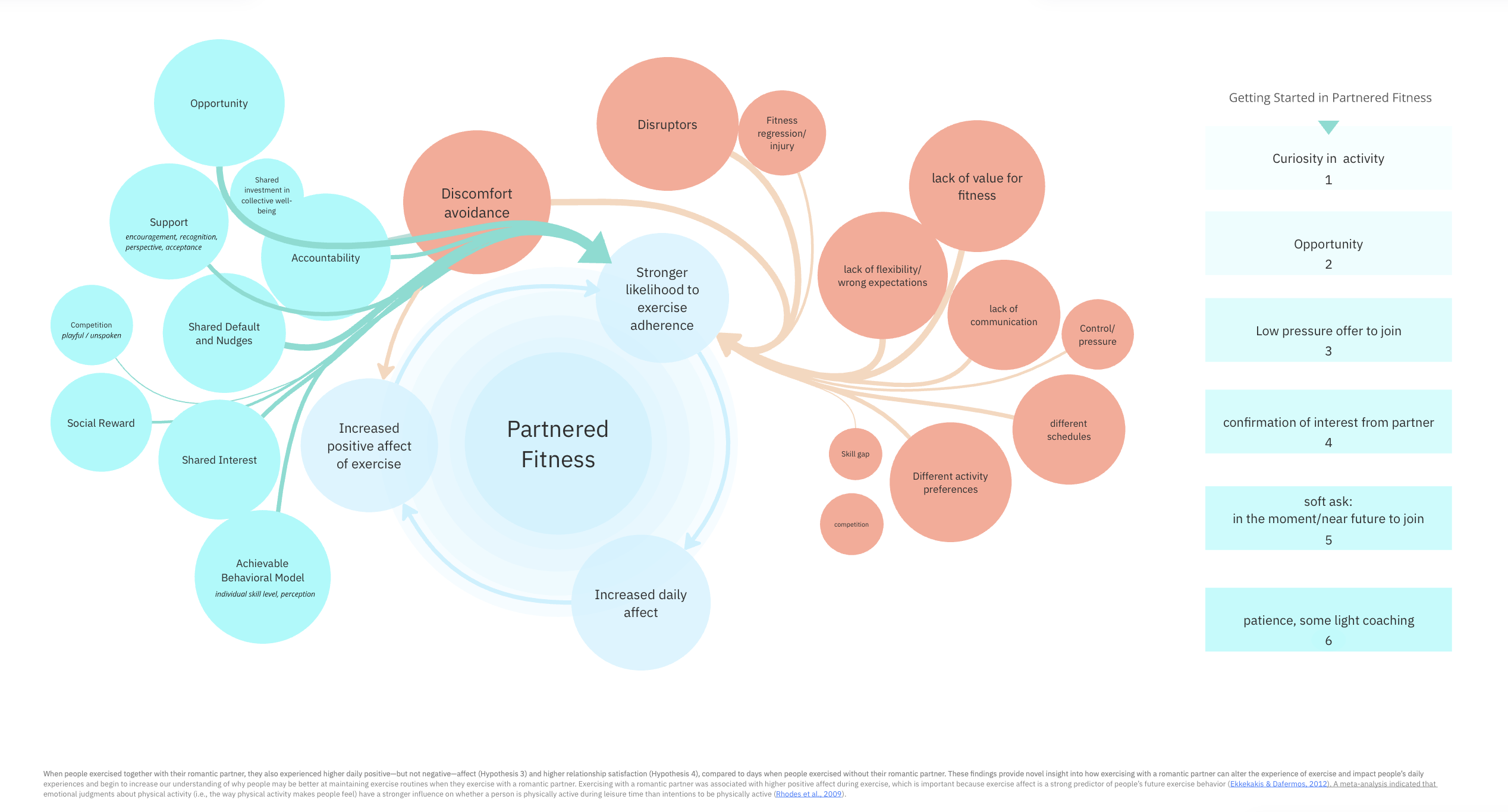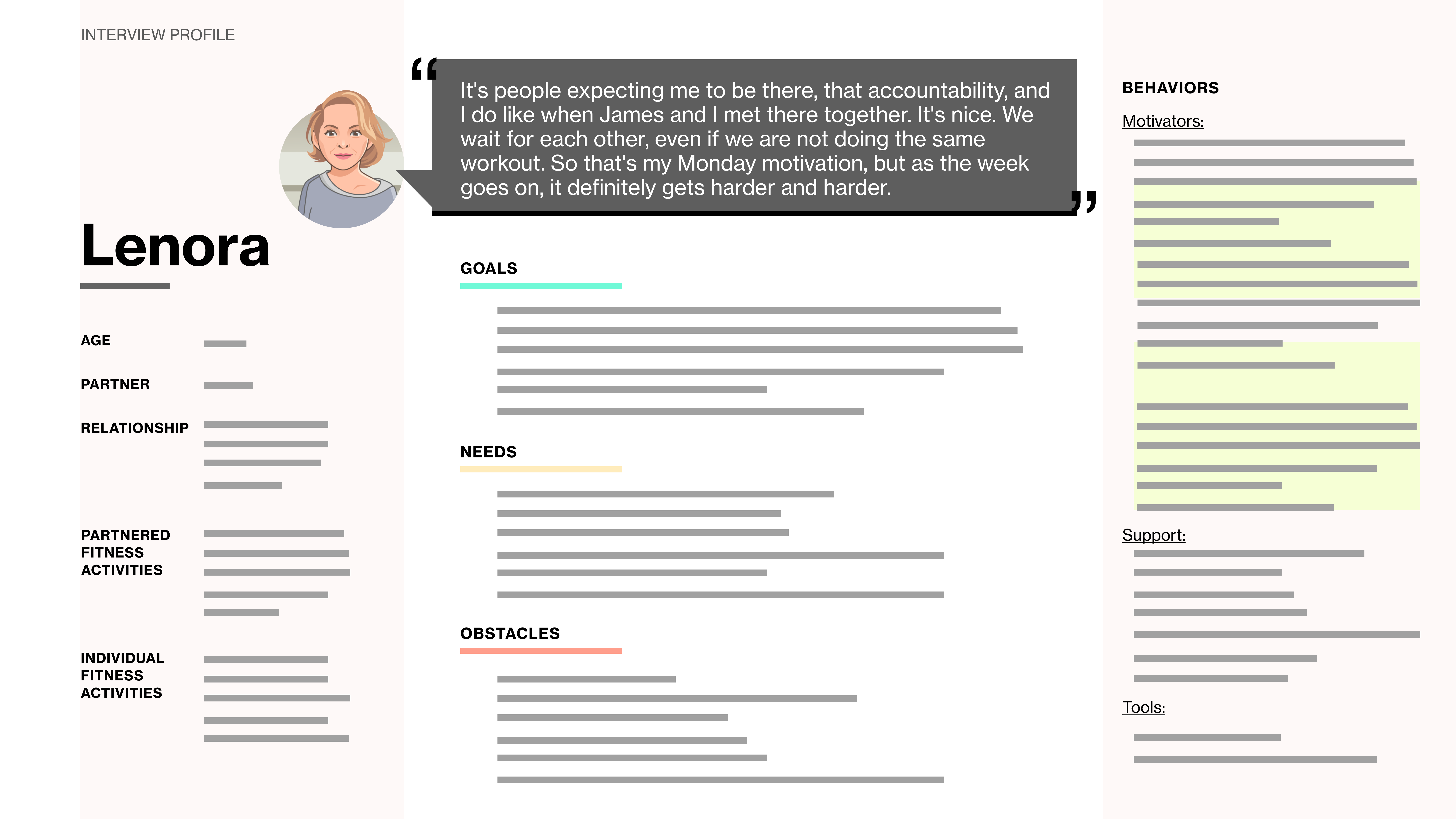A fitness product wanted to move the needle and stand apart in a crowded market, but how?
Understanding behavioral effects and building towards successful outcomes
Behavioral / fitness
4 Months, 230 hours
Interviews
Planning
Explanatory
Secondary
Data Storytelling
THOMAS JEFFERSON UNIVERSITY, PHILADELPHIA AUG - DEC 2023

3.2 million people die each year with inactivity as a key factor...
3.2 million people die each year with inactivity as a key factor [1]. In the US alone, we could not only save lives but $117 billion each year [2]. And it's not for a lack of trying. Almost half of US adults cited fitness goals as their desired change for the New Year in 2024. However, behavior change is hard. Each year, the average failure rate for these desired changes is 80% [3].
Healthcare companies and professionals have been seeking new ways to nudge people into preventive, self-care routines like exercise and healthy eating.
Can research reveal successful strategies that will reduce failure rates in exercise adherence?
Research Process:
-
Gain foundational understanding through secondary research, experts ..
-
Formulating questions and finding answers ..............................................
-
Looking for patterns ..................................................................................
-
Delivering actionable insights and next steps through data storytelling ....
Index
For this project, I worked solo but relied on industry veterans and stakeholders for constant feedback and improvement.
My responsibilities included performing secondary research, planning research objectives, writing interview scripts, facilitating user and stakeholder interviews, analyzing research, crafting synthesis artifacts, and leveraging data storytelling to create impact.
Gaining a Foothold
Building from secondary knowledge
The first step was to learn as much as possible about:
-
Size and cost of inactivity, why is this important?
-
Current state - what was already attempted and results
-
Understanding of psychology, behavioral change, habit formation
-
What challenges do people face in exercise adherence?
-
What do successful outliers do? What are the clues to impact?
-
Are there user groups with unique, unmet needs?
To carry this out, I took action through:
-
Two rounds of secondary research
-
Annotated bibliography: recent, relevant, peer-reviewed studies
-
Research from behavior change experts
-
Problem reframing exercises to find new angles to explore
-
Problem statement brief that captures important questions
1
/ 4
vs.
80%
33%
Failure Rates in Fitness Goals
Look for behavioral opportunities of impact before building
How might we reduce failure rates in exercise adherence for couples?

Finding Answers
Mapping objectives & interviewing users
With firm foundational knowledge, we set out to:
-
Prioritize objectives based on impact, feasibility
-
Define values and methods for each objective
-
Evaluate target users vs participants
-
Find and recruit participants
-
Ask the right questions
To carry this out, I personally took action on:
-
Affinity Mapping Objectives - utilizing gained knowledge to pinpoint areas of impact
-
Research Planning - defined methods and value for each objective, set timelines
-
Screener Surveys - quick survey that focused on value, participant/user alignment
-
Recruitment Strategy - cohabitating couples that have attempted fitness goals together in the past 3 months
-
User Interviews - I wrote scripts and facilitated interviews (remote and in-person)
Recruitment for this project would prove the most challenging aspect as I had no funding. Through a partnership with local gyms, I was able to offer incentives and attract participants via posters with QR codes that linked to my screener surveys. Additionally, gaining access to a social running club nearby would net high quality participants as well.
You mentioned going to the gym together on Mondays.What's good about that?
"It's people expecting me to be there, that accountability, and I do like when [we] go there together. It's nice. We wait for each other, even if we are not doing the same workout. So that's my Monday motivation, but as the week goes on, it definitely gets harder and harder.."

2
/ 4
What's Going on Here?
Analysis & synthesis on the path to insight
With firm foundational knowledge for the context, business, and users, we set out to:
-
Prioritize objectives based on impact, feasibility
-
Evaluate target users vs participants
-
Find and recruit participants
-
Ask the right questions
Synthesis artifacts, pieced together from data, tap into the core of human understanding, visuals and narrative. Visuals and narrative helps the entire team make sense of what was uncovered.
To carry this out, I personally took action on:
-
Analyzed data for patterns - going over notes, debriefs, recordings, and stats to spot clusters, outliers
-
Building data-based personas - patterns of users and their behaviors, needs, goals, and pain points
-
Mapping user journeys - what are user groups going through? how does that tie-back to objectives?
-
Highlighting insightful data - Creating visualizations that make important takeaways immediately clear

Thematic Analysis of Transcripts:
-
Social Rewards
-
Skill Gap
-
Competition
-
Support
-
Interest/Value
-
Behavior/Routine
-
Communication
-
Opportunity/Pressure
-
Accountability
-
Obstacles
-
Flexibility/Expectations
3
/ 4
Insight to Impact
Transferring knowledge to stakeholders and building toward action
To transfer knowledge gained to stakeholders and compel action, I:
-
Used narrative structures like arcs, timing, and repetition to make findings more impactful, easy to understand
-
Leveraged 'characters' throughout the story that reflected the groups of users we met and challenges they faced
-
Combined numbers with quotes, stories, and accessible data visualizations, for a one-two quant/qual punch
-
Funneled insights into hypotheses, measurable KEIs, that could be the bases of strategy and testing in the next step
Jobs-to-be Done
What does coupled fitness do for people?
INVEST IN OUR WELL BEING
exchange support and perspective in fitness goals
add accountability to fitness goals
Add Variety and social rewards to exercise
Find time to be together
To carry this out, I personally took action on:
-
Delivering Presentation - leveraging data storytelling and delivering with the dedication our users deserved
-
Revealing Insights - utilizing data visualization, participant quotes, and data storytelling techniques
-
Connecting Stakeholders - to the knowledge and empathy gained, took questions and feedback
-
Map KEIs and Initial Strategy - Prepared for next phase, mapping strategies to address insights
Insights revealed:
-
Untapped potential - 47% greater success rate of behavior change for cohabitating couples when one starts
-
Why 47%? JTBD Strategy - Fitness partnerships offer: 1. engagement and reward, 2. accountability, 3. dual task relationship building, 4. support, modeling, and perspective, 5. investment in a shared well being.
-
Opportunities - Some couples struggle to get started or maintain, difficulty balancing personal preferences/skills. Also, 47% success increase requires one partner to get started- this is still a large hurdle.

KEI
Regularly feels engagement in partnered fitness activities
pre & post survey
+15%
KEI
REGULARLY FEELs a balance of PREFERENCE and variety in fitness activities
pre & post survey
+15%
KEI
REGULARLY FEELs a SENSE OF PARTNERSHIP in fitness activities
pre & post survey
+15%

" It’s a social reward and adds accountability.
I also appreciate the goal structure we can create together."
4
/ 4

Want to find out what happens next? Read on to see these insights carried into action.
Design Strategy, Validation, and Usability Testing
4 min read
Reflection
Generating fitness engagement and adherence has an incredible impact on health, as one of the leading preventative measures against physical and mental disease. This made me all the more committed to my work in finding ways to move a needle that would benefit millions of people. The early secondary findings on cohabitating couples hinted at a high impact and feasibility solution area, as well as specific group of users that may have unmet needs. The dynamic of working with these couples added a unique layer of social and behavioral interest in this project.
-
I loved the interesting, exponential dynamics of working with coupled users and their behaviors. I had to make sure to interview participants separately and alone so that social influences would not give me poor data. Often there was overlap in the individuals but with key differences, preferences, problems.
-
The stakeholders and industry experts I worked with were amazing at providing me with understanding and ways to improve my process and skills.
-
There is something about tailoring a script and then using that to find out what is really going on for people, what they do, what issues they have, what they value. I love it.
-
Sometimes when time and budgets get tight, you have to get creative. The recruitment was a challenge in this project but finding quality networks and a little creativity in the right place yielded quality participants.
-
If I could do one thing differently, I would have loved to spend another day on reframing the problem space early on.


